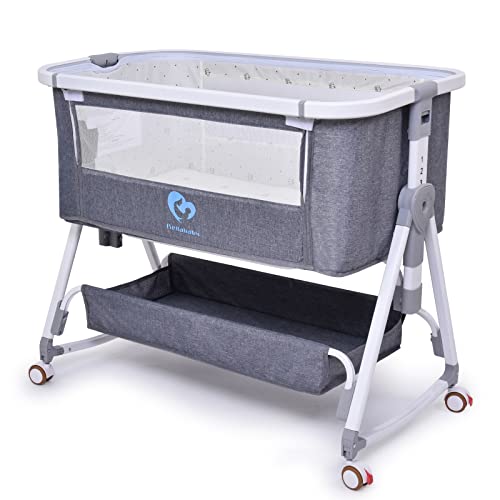The Ultimate Guide to Bedside Cots for New Parents
As new parents embark on the thrilling and in some cases overwhelming journey of raising a child, one of the vital decisions they face is where their baby will sleep. One choice that has actually gotten popularity recently is the bedside cot. Offering benefit, safety, and ease of access, these cots have become a preferred option for many parents. This article looks into the benefits, features, and considerations when selecting a bedside cot for new parents.
What is a Bedside Cot?
A bedside cot is created to connect firmly to the side of the parent's bed, enabling easy access to the baby while offering them with their own sleeping space. These cots normally feature adjustable heights, allowing them to align with the height of the adult bed, as well as safety features to make sure that the baby stays safe throughout the night.
Benefits of Using a Bedside Cot
- Ease of Access: New parents can easily choose up or relieve their baby during nighttime feedings without needing to rise.
- Lowered Risk of SIDS: Being able to keep track of the baby closely while they sleep can alleviate some worries surrounding Sudden Infant Death Syndrome (SIDS).
- Promotes Bonding: The proximity to the baby enables more moments of bonding, making it easier for parents to react to their kid's needs.
- Co-sleeping Safety: Bedside cots permit the advantages of co-sleeping while maintaining a safe sleeping environment for the infant.
- Space-Saving: These cots can fit comfortably next to adult beds, making them a convenient choice for smaller sized rooms.
Key Features to Consider
When selecting a bedside cot, it is essential to examine numerous functions to guarantee that it fulfills your requirements and those of your baby. Below is a practical table laying out critical functions to consider:
| Feature | Description |
|---|---|
| Height Adjustability | Ability to adjust the cot to line up with parent bed height. |
| Protect Attachment | Mechanism to connect the cot strongly to the adult bed. |
| Safety Standards | Compliance with security guidelines and certifications. |
| Storage Space | Under-cot storage to arrange baby basics. |
| Portability | Light-weight and easy to transfer for travel functions. |
| Mattress Quality | Non-toxic and breathable mattress for baby's convenience. |
| Reduce of Setup | Simple assembly and disassembly process. |
Types of Bedside Cots
Choosing the ideal kind of bedside cot can considerably impact its use and performance for new parents. Here are some common types:
- Traditional Bedside Cots: These are basic cots installed on wheels or a stable base that can be securely connected to the parent's bed.
- Co-sleepers: Cots developed specifically for co-sleeping enable for easy access and typically have removable sides.
- Convertible Cots: These versatile cots can transition into a regular crib or toddler bed as your child grows.
- Portable Cots: Lightweight and collapsible, they are ideal for travel while still permitting close contact with the baby.
Picking the Right Bedside Cot
With numerous options offered in the market, selecting the best bedside cot can appear difficult. New parents ought to consider the following factors:
- Space Requirements: Measure the readily available space next to the bed to ensure the cot will fit without taking control of the room.
- Spending plan: Bedside cots vary in prices. Figure out a budget plan and select a cot that fits within your financial restraints, bearing in mind that quality and security should not be compromised.
- Product & & Design: Consider the products used, ensuring they are non-toxic and safe for babies. The design ought to also complement the home decoration.
- Relieve of Cleaning: Babies can be untidy, so select cots that have detachable and washable fabrics or easy-to-clean surfaces.
- User Reviews: Reading evaluations from other parents can supply important insights into the performance and safety of the cot.
Regularly Asked Questions (FAQs)
1. What is the advised age for using a bedside cot?
The majority of bedside cots are ideal for infants from birth approximately around 6 months, however this differs depending upon the specific design and design. Constantly describe the maker's guidelines.
2. Bedside Sleeper cots safe for newborns?
Yes, as long as the cot satisfies security requirements, is properly connected to the moms and dad's bed, and is used according to the maker's guidelines.
3. Can I use a regular crib as a bedside cot?
Routine cribs are generally not created for bedside use, as they do not attach securely to beds. It's finest to use a cot particularly designed for this function.
4. How do I make sure the bedside cot does stagnate during use?
Always inspect that the attachment system is securely attached to the bed and think about using anti-slip pads for added stability.
5. How do I select the ideal bed mattress for a bedside cot?
Try to find a firm, breathable bed mattress designed for infants that fulfills safety requirements and fits comfortably within the cot without gaps.
Bedside cots provide a practical option for new parents, offering convenience, security, and the capability to bond carefully with their newborns. With numerous designs and functions offered, parents should thoroughly assess their private needs and preferences to make an informed option. Eventually, selecting a top quality bedside cot can improve the early parenting experience, ensuring both the baby's safety and the parents' comfort.

